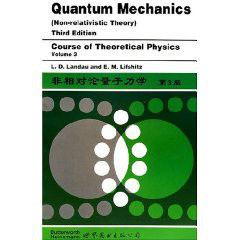內容簡介
THEpreviouseditionofthisvolumewasthelastbookonwhichIworkedtogetherwithmyteacherL.D.Landau.Therevisionandexpansionthatwethencarriedoutwasveryconsiderable,andaffectedeverychapter.Forthethirdedition,naturally,muchlessrevisionwasneeded.Nevertheless,afairamountofnewmaterialhasbeenadded,includingsomemoreproblems,andrelatingbothtorecentresearchandtoearlierresultsthathavenowbecomeofgreatersignificance. 此書為英文版。
目錄
From the Preface to the first English edition
Preface to the second English edition
Preface to the third Russian edition
Editor's Pretace to the Iburth Russian edition
Notation
Ⅰ. THE BASIC CONCEPTS OF QUANTUM MECHANICS
1. The uncertainty principlc
2. The principle of superposition
3. Operators
4. Addition and multiplication of operators
5. The continuous spectrum
6. The passage to the limiting case of classical mechanica
7. The wave function and measurements
Ⅱ. ENERGY AND MOMENTUM
8.The Hamiltonian operator
9. The differentiation of operators with respect to time
10. Stationary states
11. Matrices
12. Transformation of matrices
13. The Heisenberg representation of operators
14. The density matrix
15. Momentum
16. Uncertainty relations
Ⅲ. SCHRODINGER'S EQUATION
17 Schrodinger's equation
18. The fundamental properties of Schrodinger's equation
19. The current density
20. The variational principle
21. General properties of motion in one dimension
22. The potential well
23. The linear oscillator
24. Motion in a homogeneous field
25. The transmission coefficient
Ⅳ. ANGULAR MOMENTUM
26. Angular momentum
27. Eigenvalues of the angular momcntum
28. Eigenfunctions of the angular momentum
29.Matrix elements of vectors
30.Parity of a state
31.Addition of angular momenta
Ⅴ. MOTION IN A CENTRALLY SYMMETRIC FIELD
32. Motion in a centrally symmetric field
33. Spherical waves
34. Resolution of a plane wave
35. Fall of a particle to the centre
36. Motion in a Coulomb field (spherical polar coordinates)
37. Motion in a Coulomb field (parabolic coordinates)
VI. PERTURBATION THEORY
38. Perturbations indcpendent of time
39. The secular equation
40. Perturbations depending on time
41. Transitions under a perturbation acting for a finite time
42. Transitions under the action of a periodic perturbation
43. Transitions in the continuous spectrum
44. The uncertainty relation for energy
45. Potential energy as a perturbation
Ⅶ. THE QUASI-CLASSICAL CASE
46. The wave function in the quasi-classical case
47. Boundary conditions in the quasi-classical case
48. Bohr and Sommerfeld's quantization rule
49. Quasi-classical motion in a centrally symmetric field
50. Penetration through a potential barricr
51. Calculation of the quasi-classical matrix elements
52. The transition probability in the quasi-classical case
53. Transitions under the action of adiabatic perturbations
Ⅷ SPIN
54. Spin
55. The spin operator
56. Spinors
57. The wave functions of particles with arbitrary spin
58. The operator of finite rotations
59. Partial polarization of particles
60. Time reversal and Kramers' theorem
Ⅸ. IDENTITY QF PARTICLES
61. The principle of indistinguishability of similar particles
62. Exchangc interaction
……
Ⅹ THE ATOM
Ⅺ THE DIATOMIC MOLECULE
XII THE THEORY OF SYMMETRY
XIII POLYATOMIC MOLECULES
XV MOTION IN A MAGNETIC FIELD
XVI NUCLEAR STRUCTURE
XVII. ELASTIC COLLISIONS
XVIII INELASTIC COLLISIONS
MATHEMATICAL APPENDICES
Index

